#early dynastic period (mesopotamia)
Explore tagged Tumblr posts
Text
The two sides of the Standard appear to be the two poles of Sumerian kingship, war and peace. The war side was found face up and is divided into three registers (bands), read from the bottom up, left to right. The story begins at the bottom with war carts, each with a spearman and driver, drawn by donkeys trampling fallen enemies, distinguished by their nudity and wounds, which drip with blood. The middle band shows a group of soldiers wearing fur cloaks and carrying spears walking to the right while bound, naked enemies are executed and paraded to the top band where more are killed.
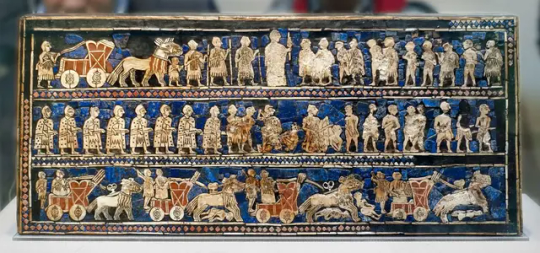

In the center of the top register, we find the king, holding a long spear, physically larger than everyone else, so much so, his head breaks the frame of the scene. Behind him are attendants carrying spears and battle axes and his royal war cart ready for him to jump in. There is a sense of a triumphal moment on the battlefield, when the enemy is vanquished and the victorious king is relishing his win. There is no reason to believe that this is a particular battle or king as there is nothing which identifies it as such; we think it is more of a generic image of a critically important aspect of Ancient Near Eastern kingship.
The opposite peace panel also illustrates a cumulative moment, that of the celebration of the king, this time for great agricultural abundance which is afforded by peace. Again, beginning at the bottom left, we see men carrying produce on their shoulders and in bags and leading donkeys. In the central band, men lead bulls, sheep and goats, and carry fish. In the top register a grand feast is taking place, complete with comfortable seating and musical accompaniment.
On the left, the largest figure, the king, is seated wearing a richly flounce fur skirt, again so large, even seated, he breaks the frame. Was it an epic tale of battle that the singer on the far right is performing for entertainment as he plays a bull’s head lyre, again, like the Queen’s Lyre? We will never know but certainly such powerful images of Sumerian kingship tell us that [whoever] ended his life with the Standard of Ur on his shoulder was willing to give his life in a ritual of kingly burial.
#studyblr#history#military history#archaeology#art#art history#music#music history#anthropology#sociology#politics#transport#animals#food and drink#agriculture#early dynastic period (mesopotamia)#mesopotamia#sumer#ur#leonard woolley#standard of ur#chariots#lyre#lapis lazuli
3 notes
·
View notes
Text
Mesopotamian religion was central to the people's lives. Humans were created as co-laborers with their gods to hold off the forces of chaos and to keep the world running smoothly. As in ancient Egypt, the gods were honored daily for providing humanity with life and sustenance, and people were expected to give back through works that honored the gods.
It was understood that, in the beginning, the world was undifferentiated chaos and that order was established by the gods. The gods had separated the sky from the earth, the land from the water, saltwater from freshwater, plants from animals, and this order needed to be maintained. As the gods had many different responsibilities, humans were created to help them in the operation of the world. The meaning of life, therefore, was to live in accordance with this understanding, and so one's daily life would be a form of worship.
Every city had a temple complex clearly visible from afar for its ziggurat, the monumental architecture most closely associated with Mesopotamia, which was usually topped by a temple or shrine, elevating the officiant closer to the gods. The gods were understood as inhabiting their own realm but also living in the temple, in the statues created in their images in every city. This belief was already firmly in place by the time of the Uruk Period (4100-2900 BCE) and developed fully during the Early Dynastic Period (2900-2334 BCE).
Although Mesopotamian religion changed in focus and the names of the deities over the centuries, the central understanding of the relation between humanity and the gods did not. As late as c. 650 CE, the people of Mesopotamia still adhered to the belief that they were the gods' coworkers who assisted in the maintenance of order. This paradigm only changed after 651 CE with the invasion of the Muslim Arabs and the new monotheistic religious model of Islam.
#studyblr#history#religion#mesopotamian religion#sumerian religion#uruk period#early dynastic period (mesopotamia)#early muslim conquests#mesopotamia#sumer
1 note
·
View note
Photo
"The Standard of Ur", decorated on four sides with inlaid mosaic scenes made from shell, red limestone and lapis lazuli, set in bitumen. One side shows a war scene; a Sumerian army with wheeled waggons and infantry charges the enemy; prisoners are brought before a larger individual, who is accompanied by guards and has his own waggon waiting behind him. The reverse shows scenes of men are bringing animals, fish etc, possibly as booty or tribute; at the top the same large individual banquets with other men; they are entertained at the right by a singer and a man playing a lyre. The triangular end panels show other scenes; the object was found crushed but has since been restored, and samples retained.

The Standard of Ur, Royal Cemetery of Ur, Tell el-Muqayyar, Iraq (c.2600-2400 BCE)
“Leonard Woolley, the excavator at Ur, imagined that it was carried on a pole as a standard, hence its common name. Another theory suggests that it formed the soundbox of a musical instrument… The main panels are known as ‘War’ and 'Peace’. 'War’ shows one of the earliest representations of a Sumerian army. Chariots, each pulled by four donkeys, trample enemies; infantry with cloaks carry spears; enemy soldiers are killed with axes, others are paraded naked and presented to the king who holds a spear.The 'Peace’ panel depicts animals, fish and other goods brought in procession to a banquet. Seated figures, wearing woollen fleeces or fringed skirts, drink to the accompaniment of a musician playing a lyre.“ (Source)
#history#military history#art#art history#music#music history#transport#animals#food and drink#alcohol#clothing#early dynastic period (mesopotamia)#mesopotamia#sumer#ur#leonard woolley#standard of ur#lyre#chariots#wagons#lapis lazuli#sumer ref#standard of ur ref
24 notes
·
View notes
Photo
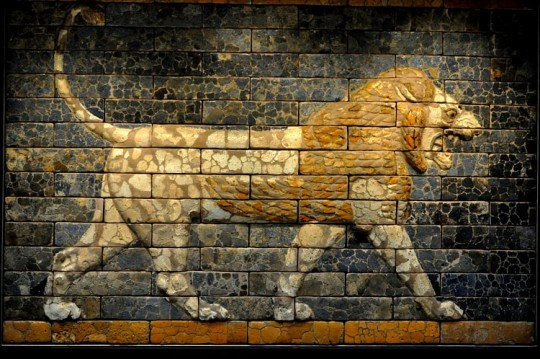
Mesopotamian Art and Architecture
Ancient Mesopotamian art and architectural works are among the oldest in the world, dating back over 7,000 years. The works first appear in northern Mesopotamia prior to the Ubaid Period (c. 5000-4100 BCE) and then developed in the south during the Uruk Period (4100-2900 BCE) in Sumer which established the first historical civilization.
According to some scholars, the works of the Indus Valley Civilization (c. 7000 to c. 600 BCE) pre-date those of Mesopotamia, but the Indus Valley developments do not appear until the Early Harappan Period (c. 5500-2800 BCE) by which time Mesopotamian works were already established. Early artwork and construction are evidenced in northern Mesopotamia at sites such as Göbekli Tepe (c. 10,000 BCE) and Ҫatalhöyük (c. 7500 BCE), both in modern-day Turkey, and Tell Brak (c. 6500-5000 BCE), in Syria.
The development of these works then progressed through the following eras, though, owing to space limitations, the Hittite and Kassite periods will not be addressed:
Ubaid Period – c. 5000-4100 BCE
Uruk Period – 4100-2900 BCE
Early Dynastic Period – 2900-2334 BCE
Akkadian Period – 2334-2218 BCE
Ur III Period – 2047-1750 BCE
Old Babylonian Period – c. 2000-1600 BCE
Hittite Period – 1700-1200 BCE
Kassite Period – c. 1595 to c. 1155 BCE
Assyrian Period – c. 1307-912 BCE
Neo-Assyrian Period – 912-612 BCE
Neo-Babylonian Period – 626-539 BCE
Achaemenid Persian-Sassanian Persian Period – c. 550 BCE to 651 CE
Artworks included reliefs, sculpture, statuary cast in metal, ceramics, jewelry, cylinder seals, stele & monuments, obelisks, and wall paintings. Mesopotamian monumental architecture is epitomized by the ziggurat, but the Sumerians were also responsible for the first large-scale palaces and temples, as well as urban planning, the arch, canals, and aqueducts, landscaped gardens, and architectural ornamentation. These early innovations would become more refined in the region through succeeding periods and influence the works of other cultures in the Near East and Mediterranean regions.
Earliest Sites & Base Materials
Although the Göbekli Tepe site is dated to c. 10,000 BCE, the first permanent settlements in that area are thought to have been established earlier, and, possibly, for the sole purpose of building the structure which most scholars believe was a temple. Göbekli Tepe is among the earliest sites, along with others such as Nevalı Çori (also in modern-day Turkey), to feature monumental architecture – including the oldest known megaliths in the world at Göbekli Tepe – as well as reliefs.
Architecturally, the site is comprised of circular areas and rectangular buildings with T-shaped pillars of limestone, some carved with images of wildlife in low and high relief. There is little evidence of human activity in the sculptures which seem to emphasize the natural world and, in some interpretations, the people's relationship with their gods. Some scholars associate the site with the later settlement of Ҫatalhöyük, though this claim has been challenged as the design of Göbekli Tepe, and the tools found there, differ from the later site.
Whatever purpose Göbekli Tepe originally served, it was a communal site associated with ritual, while Ҫatalhöyük was entirely residential. No public buildings have been found at the site which is comprised of tightly clustered mudbrick residences accessed by ladders or steps from a hole in the roof. Artwork from the site includes murals and statuary – such as the famous Seated Woman of Ҫatalhöyük – as well as ceramics. The artwork seems to focus on the natural world and the concept of fertility as several pieces represent female figures and erect phalluses.
The people of Ҫatalhöyük used clay, limestone, marble, and other materials for their statuary and paint created from natural substances. The figurines, statuary, and murals are usually interpreted as representing religious concepts, but this claim is not universally accepted. There is no evidence of urban planning at the site; it seems to have developed organically with buildings attached to each other and people using the rooftops for communal activities and movement as there are no streets, courtyards, or public squares.
Continue reading...
123 notes
·
View notes
Text

human figurine | c. 2900-2600 BCE | mesopotamia, early dynastic period
51 notes
·
View notes
Text




Anu 𒀭 “Skyfather and Lord of Firmament, or the Great Above.” Talon Abraxas
Anu (also known as An) is an early Mesopotamian sky god who was later viewed as the Father of the Gods and ruler of the heavens, a position which then passed to his son Enlil. He is the son of the couple Anshar and Kishar (heaven and earth, respectively), the second-born of the primordial couple Apsu and Tiamat.
He was originally a Sumerian sky deity known as An (meaning 'sky') first referenced in writing during the Early Dynastic Period (2900-2334 BCE) who was adopted by the Akkadians c. 2375 BCE as Anu ('heaven') the all-powerful. Sargon the Great of Akkad (r. 2334-2279 BCE) mentions Anu and Inanna in his inscriptions as legitimizing his rule or helping him in his conquests as he established the Akkadian Empire and maintained order.
Anu is most often represented in iconography simply by a crown or crown on a throne symbolizing his status as King of the Gods, an honor and responsibility later conferred upon Enlil, Marduk (son of Enki/Ea, the god of wisdom), and Assur of the Assyrians, all of whom were believed to have been elevated by Anu and blessed by him. His consort is Antu (also known as Uras, goddess of the earth), and among their many children are the Annunaki, the gods of the earth and judges of the dead, and Nisaba, the Sumerian goddess of writing and accounts. He is also given as the husband of his sister Ki (earth) by whom his son Enlil is born.
Although Anu is not featured prominently in many myths, he is often mentioned as a background figure. This is because, as veneration of the god progressed, he became more and more remote. Initially a sky god and one of the many younger gods born of Apsu and Tiamat, Anu gradually became the lord of the heavens above the sky and the god who ordered and maintained all aspects of existence.
Along with Enlil and Enki, Anu formed a triad which governed the heavens, earth, and underworld (in one version) or, in another, heaven, the sky, and the earth. He was also listed among the oldest gods of the Seven Divine Powers: Anu, Enki, Enlil, Inanna, Nanna, Ninhursag, and Utu-Shamash.
Even though he is rarely a main character in a myth, when he does appear, he plays an important role, even when that role might seem minor. He is referenced in some of the best-known myths from Mesopotamia including Gilgamesh, Enkidu, and the Netherworld, The Epic of Gilgamesh, the Myth of Adapa, and the Enuma Elish.
53 notes
·
View notes
Text
New Ninshubur myth (sort of)
Kamran V. Zand's article Mesopotamia and the East: The Perspective from the Literary Texts from Fāra and Tell Abū Ṣalābīḫ is interesting in general but it caught my attention first and foremost because it adds another myth to the repertoire of literary texts in which Ninshubur appears. The composition in mention is an example of UD.GAL.NUN, a notoriously difficult to decipher form of cryptography used in the Early Dynastic period for uncertain reasons. The plot is not particularly complex: the gods gather and decide to entrust Utu with traveling to a variety of places outside Mesopotamia to bring various wares, animals and in some cases deities from over there. The very first journey described involves bringing Ninshubur from her original residence, the "mountain lands of Subartu" (kur šubur). Technically this doesn't say much that we wouldn't know already - Ninshubur's association with Subartu is reflected by her very name - but as far as I am aware this is the only literary text to explicitly depict her as a former resident of a foreign land brought to Mesopotamia. Interestingly, the same myth also states that Utu's wife Sherida (better known under her Akkadian name Aya, though Sherida might ultimately be an Akkadian loanword in Sumerian too) was brought to Mesopotamia from the west ("Amurru"). As far as I am aware this is the closest to an origin myth she has.
23 notes
·
View notes
Text
Headdress—Ur, Mesopotamia (now Iraq), 2600-2500 BCE

According to the Met: "Kings and nobles became increasingly powerful and independent of temple authority during the course of the Early Dynastic period (2900–2350 B.C.), although the success of a king's reign was considered to depend on support from the gods. A striking measure of royal wealth was the cemetery in the city of Ur, in which sixteen royal tombs were excavated in the 1920s and 1930s by Sir Leonard Woolley. These tombs consisted of a vaulted burial chamber for the king or queen, an adjoining pit in which as many as seventy-four attendants were buried, and a ramp leading into the grave from the ground.
This delicate chaplet of gold leaves separated by lapis lazuli and carnelian beads adorned the forehead of one of the female attendants in the so-called King's Grave. In addition, the entombed attendants wore necklaces of gold and lapis lazuli, gold hair ribbons, and silver hair rings. Since gold, silver, lapis, and carnelian are not found in Mesopotamia, the presence of these rich adornments in the royal tomb attests to the wealth of the Early Dynastic kings as well as to the existence of a complex system of trade that extended far beyond the Mesopotamian River valley."
12 notes
·
View notes
Text

Seal: Pattern of Two Running Goats, One Above the Other
Mesopotamia, Early Dynastic I period (c.2900-2750 BCE); serpentine inscription (illegible) added c.400 BCE
on display at Morgan Library
“Several styles prevailed in the glyptic art of Early Dynastic I. The example shown here (No. 10) belongs to the ‘Brocade’ style.”
#animals in art#goat#goats#seal#ancient art#Mesopotamian art#Morgan Library#museum visit#brocade style#pattern
24 notes
·
View notes
Text
It is characteristic of leadership in this early period that there is a merging of divine and secular power personified by the ruler. The king list, a document written down in about 1800 B.C., traces the successive dynasties for the major cities in Mesopotamia back into the third millennium. While the chronologies are somewhat inflated, archaeologists have verified some of the data with other evidence. The earliest Sumerian dynasties were based in the cities of Kish, Warka, and Ur. According to the king list, the founder of the dynasty of Kish was Queen Ku-Baba, who is listed as having reigned a hundred years. She is identified as having formerly been a tavern-keeper, an occupation which puts her at the margins of society. She was later identified with the goddess Kubaba, who was worshiped in Northern Mesopotamia. She is the only woman listed in the king list as reigning in her own right, but the merging of her historic personality with that of a divinity is not unlike that of the mythical demigod Gilgamesh, ruler of Warka, who supposedly reigned in the Early Dynastic period, but for whose historical existence there is no hard evidence, and whose exploits are immortalized in the epic of Gilgamesh.
-Gerda Lerner, The Creation of Patriarchy
46 notes
·
View notes
Text
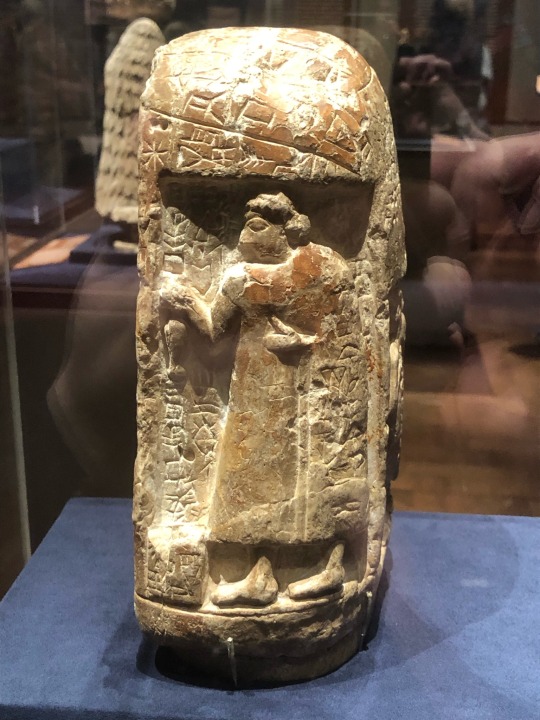

A while ago I saw an exhibit that included this carving, the oldest known piece of art that bears the artist’s signature.
It’s thousands of years old, and we know the name of the artist: Enhegal
That just gets me so emotional
(Transcript of the text is below the cut)
WOMEN OF PROMINENCE
38 Stele of Shara-igizi-Abzu
Mesopotamia, Sumerian, possibly Umma (modern Tell Jokha)
Early Dynastic I-II period, ca. 2900-2600 BC
Cuneiform inscription identifying Shara-igizi-Abzu; her father, Ushumgal; and four other represented figures, including: IGI.RU?.NUN, daughter of Mesi; Ag, chief of the assembly; Nanna, the foreman of the assembly; X.KU.EN, chief herald; Enhegal, the maker of the stele
Gypsum alabaster
This stele, bearing the earliest known signature of an artist, records one of the first transactions involving land, livestock, and houses. The two principal figures - Ushumgal, a priest of the god Shara, and his daughter Shara-igizi-Abzu - face one another on two sides. They are identified by inscriptions carved on their bodies. Shara-igizi-Abzu, who holds a vessel in her right hand, is shown taller than her father. Behind her appears a smaller female figure, and behind Ushumgal are three male figures in two registers, all of whom may have witnessed the transaction that takes place in front of a monumental building. Shara-igizi-Abzu's prominent appearance suggests that the stele documents Ushumgal's donation of an estate on her behalf.
THE METROPOLITAN MUSEUM OF ART, NEW YORK, FUNDS FROM VARIOUS DONORS, 1958; 58.29
6 notes
·
View notes
Text
Deity Dagan
Originally a god of West Semitic speakers from the Levant, but worshipped widely throughout the Near East, including Mesopotamia.
Deity of grain, as well as its cultivation and storage. Indeed, the common word for "grain" in Ugaritic and Hebrew is dagan. According to one Sumerian tradition and to the much later Philo of Byblos, Dagan invented the plow. In the north, he was sometimes identified with Adad. Thus, he may have had some of the characteristics of a storm god. In one tradition his wife was Ishara, in another Salas, usually wife of Adad. Salas was originally a goddess of the Hurrians. Dagan also had netherworld connections. According to an Assyrian composition, he was a judge of the dead in the lower world, serving with Nergal and Misa-ru(m), the god of justice. A tradition going back at least to the fourth century BCE identified Dagan as a fish god, but it is almost certainly incorrect, presumably having been based upon a false etymology that interpreted the element "Dag" in Dagan as deriving from the Hebrew word dag "fish."
The earliest mentions of him come from texts that indicate that, in Early Dynastic times, Dagan was worshipped at Ebla. Dagan was taken into the Sumerian pantheon quite early as a minor god in the circle of Enlil at Nip-pur. Kings of the Old Akkadian peri-od, including Sargon and Narām-Sin, credited much of their success as conquerors to Dagan. Sargon recorded that he "prostrated (himself in prayer before Dagan in Tutul [sic]" (Oppen-heim, ANET: 268). At the same time, he gave to the god a large area of the country he had just conquered, including Mari, Ebla, and larmuti in western Syria. A number of letters from the Mari archives, dated mainly to the reign of Zimri-Lim, record that Dagãn was a source of divine revela-tion. The letters reported prophetic dreams, a number of which came from Dagan, conveyed by his prophets and ecstatics. In his law code, Hammu-rapi credits Dagan with helping him subdue settlements along the Euphrates.
The Assyrian king Samsi-Adad I commissioned a temple for him at Terqa, upstream from Mari, where funeral rites for the Mari Dynasty took place.
In the Old Babylonian period, kings of the Amorites erected temples for Dagan at Isin and Ur. In the Anzû(m) myth, Dagan was favorably coupled with Anu(m). At Ugarit Dagan was closely associated with, if not equated to, the supreme god El/I(u). Although he is mentioned in the mythic compositions of Ugarit as the father of the storm god Ba'lu/ Had(d)ad, Dagan plays only a very minor role. His popularity is indicated by his importance in offering and god lists, one of which places him third, after the two chief gods and before the active and powerful god Ba'lu/ Had(d)ad. Dagan is attested in Ugaritic theophoric names. In Ugaritic texts the god is often referred to as "Dagan of Tuttul." It might also be the case that one of the two major temples of the city of Ugarit was dedicated to him, and he might there have been identified with the chief god I(u) / El.
Festivals for Dagãn took place at Ter-ga and Tuttul, both of which were cult centers of the god. He was certainly worshipped at Ebla and also at Mari.
At Mari, in Old Babylonian times, he appears as fourth deity on a god list; that is, he was very important. He was venerated also at Emar. There a "Sacred Marriage" ritual between Dagan and the goddess Nin-kur was celebrated.
At the same city, a festival was held in honor of "Dagan-Lord-of-the-Cattle," at which the herds of cattle and prob. ably sheep were blessed.
According to the Hebrew Bible, Dagan was the national god of the Philistines. I Samuel:5-6 tells of the capture of the Ark of the Covenant by the Philistines. It was customary in the Ancient Near East for the conquerors to carry off the deity statues of the conquered to mark the surrender not only of the people, but also of their deities.
So the Philistines took the Ark, the symbol of the god of the Israelites, into the temple of Dagan at Ashdod. Since the Israelites had no statues of their deity, the much revered Ark was an obvious substitute. In this way, the Philistines marked the submission of the Israelite god to Dagan. However, on the next day, the people of Ashdod found the statue of Dagan lying face down in front of the Ark. The following day the same thing happened except that the head and hands of Dagan's statue lay broken on the temple threshold. This biblical account seems to be an etiology for a practice of the priests of the temple of Dagan at Ashdod, for it states that for this reason it is the custom of the priests of Dagan not to tread on the threshold as they enter the temple of Dagan. The best-known of the biblical stories that mention Dagan is in Judges 16, the tale of Samson and Delilah. After Delilah arranged for the Philistines of Gaza to capture Samson, they blinded him, shackled him, and made him a slave at a mill. During a festival to Dagan, the Philistines took Samson to be exhibited in Dagan's temple, where thou sands of Philistines had gathered for the celebrations. After praying to the Israelite god, the now long haired Samson got back his old strength. By pushing against two central pillars, he brought the temple crashing down on himself and on more Philistines than he had killed in his whole lifetime of killing Philistines.
— From a Handbook to Ancient Near Eastern Gods & Goddesses by Frayne & Stuckey page 67-69
#pagan#polytheism#levpag#philistines#israelites#canaanites#assyrians#1 samuel#tanakh#mesopotamians#dagan#dagan deity#deity#god#quote#sumerian polytheism#levant#ancient near east#landof2rivers#quote pile#put this in text for someone so thought id post it#eblaite#ebla
10 notes
·
View notes
Text
The Early Dynastic Period of Mesopotamia is the modern-day archaeological term for the era in Mesopotamian history – 2900-2334 BCE – during which some of the most significant cultural advances were made including the rise of the cities, the development of writing, and the establishment of governments.
This era was preceded by the Uruk Period (4100-2900 BCE) when the first cities were established in the region of Sumer (southern Mesopotamia) and succeeded by the Akkadian Period (2334-2218 BCE) when Mesopotamia was conquered by Sargon of Akkad (r. 2334-2279 BCE) and ruled by him and his successors as the Akkadian Empire.
The term Early Dynastic Period was coined by Orientalist Henri Frankfort (l. 1897-1954 CE) to mirror the Early Dynastic Period in Egypt, a similar period of development. It should be noted, however, that the advances of Mesopotamia's Early Dynastic Period differed from Egypt's in significant ways, notably in that Mesopotamia – even under the rule of Sargon or later empires – was never the cohesive ethnic or political entity Egypt was and the kinds of cultural development cited for this era were not as uniform as they were in Egypt.
The city-states of Sumer were, for much of their history, each independently governed – not united under the reign of a single king as in the case of Egyptian government – and so a city like Uruk or Ur might have developed some important cultural advance which was not shared – at least not readily – with others.
The era is divided by archaeologists into three subperiods:
Dynastic I – 2900-2800 BCE
Dynastic II – 2800-2600 BCE
Dynastic III – 2600-2334 BCE
These are considered arbitrary divisions by some scholars and historians as there is no clear demarcation line separating one from the next. Even so, there is enough of a subtle difference that division is considered justified.
#studyblr#history#military history#archaeology#civilization#politics#sociology#invention#languages#writing#uruk period#early dynastic period (mesopotamia)#akkadian period#mesopotamia#sumer#akkadian empire#uruk#ur#iraq#kuwait#sargon of akkad#henri frankfort#sumerian language#cuneiform#sumerian cuneiform
1 note
·
View note
Photo

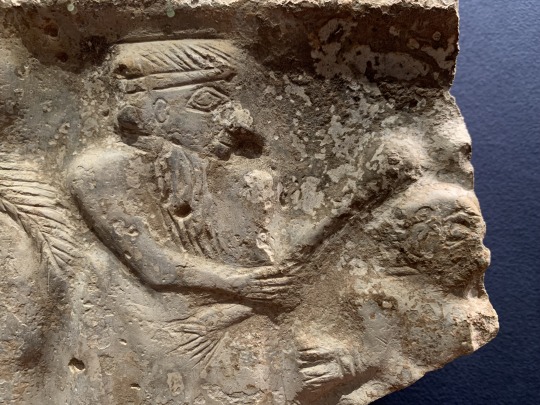
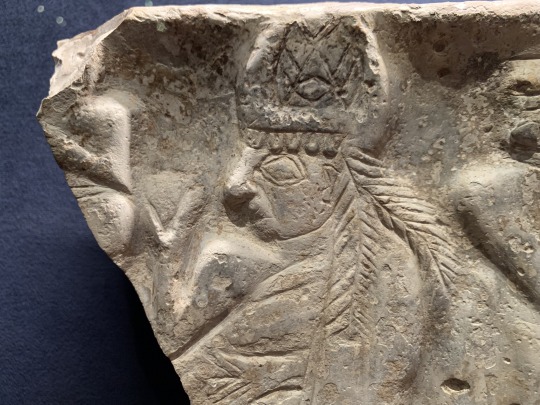
Fragment of a stele depicting seated goddess and king with mace, striking a bound prisoner Calcite Girsu (modern Tello), Iraq Sumerian, Early Dynastic IIIb period, ca. 2500-2334 BCE
Musée du Louvre, AO 48 On display in the exhibition She Who Wrote: Enheduanna and the Women of Mesopotamia at the Morgan Library, New York, January 2023
10 notes
·
View notes
Photo

A Gallery of Lions of Mesopotamia
The Asiatic lion in Mesopotamia symbolized the forces of chaos, which the king defeated in his role as a champion of order and civilization. Lions appear in works of art from the Early Dynastic Period through the time of the Neo-Assyrian Empire as a symbol of the ruler’s strength in defeating untamed forces that threatened stability.
Lions frequently attacked livestock on the Mesopotamian plains, threatened merchants traveling the roads, and killed herdsmen, shepherds, dogs, children, and others. They came, therefore, to symbolize the chaotic nature of the untamed world – the world thought to exist outside of the civilized and orderly realm of a given monarch – and so threats to that order needed to be neutralized.
Lion hunts, whether in the wild or staged in an arena or park, were reserved solely for the king. In Mesopotamian belief – whether Sumerian, Akkadian, Babylonian, or Assyrian – humans were understood as co-workers with the gods. The gods had established order at the beginning of time, and it was up to the people to maintain it. The king, as the divinely appointed leader of his people, was expected to serve as a role model and the lion hunt, in which the lion represented the threat of chaos and destruction, provided him the opportunity to do so publicly.
Lions were depicted in statuary and reliefs to illustrate how the king had tamed the wild forces of nature – as in the lion reliefs from the walls of the Ishtar Gate of Babylon – as the lion in these works is no longer a dangerous menace roaming freely but has been caught by the king and held eternally. The king, then, took the power from the lion as his own, and so lions came to symbolize royal authority in maintaining order and supremacy over any threats to that order, in the same way that imagery associating the lion with a deity – such as Ishtar – would do. A statue or image of a lion assured the people that the king, anointed by the gods, was in control and would protect them from all dangers.
Continue reading...
127 notes
·
View notes
Note
🌹
“Seriously, though, in my case it’s usually research rabbit holes. I get started looking for something, I find a reference to something else that catches my attention, I start looking at that, and next thing I know the library’s closing and I have zero notes for the essay due tomorrow on the Corn Laws but I do have an almost excessive level of knowledge about the symbolism of pottery in the early dynastic period of ancient Mesopotamia.”
Send me a 🌹 to get a line from a WIP!
5 notes
·
View notes